We have flown one of the world’s
most advanced jet trainers: the
M-346 of the Italian Air Force

Chosen by Italy, Israel, Poland
and Singapore to prepare their
pilots to the 4th and 5th Gen.
fighter jets, the Alenia
Aermacchi M-346 “Master” is
considered one the world’s
most advanced jet trainers.
The never-ending evolution of
the front-line warplanes that
operate in a hi-tech battlefield
with new generation avionics,
PGMs (Precision Guided
Munitions), EW (Electronic
Warfare) suites and several
hi-tech sensors, has called
for the redesign of the
training syllabus: rather than
learning to fly fast jets, at a
certain point of their training
process, student pilots are
required to become proficient
at employing modern weapons
systems in complex missions,
in high-threat/high
performance environments.
The Alenia Aermacchi M-346
“Master” is a dual-engine LIFT
(Lead-In to Fighter Trainer) jet
selected by Italy, Poland, Israel
and Singapore for advanced
pre-operative training, the
latest stage of a fighter pilot
training, which aims to develop
the information management
and aircraft handling skills of
future pilots before they are
assigned to the OCUs
(Operational Conversion Units).
The “Master” couples cutting
edge equipment with
impressive performance for a
plane of its type: the jet
features a high thrust-to-weight
ratio, supersonic speed at high
altitude, and a maneuverability
similar to those of the leading
combat aircraft. It is equipped
with a HUD (Head Up Display),
HOTAS (Hands On Throttle
And Stick), VCI (Vocal Control
Inputs), and a Helmet Mounted
Display system built around a
lightweight HGU-55P helmet,
with a night module that can
to be fitted to the standard
NVG eyepiece kit that works
by overlaying the HMD
symbology to that of the NVG
imagery. In other words, it is
equipped with all the
“accessories” pilots can find
in the Eurofighter Typhoon, the
F/A-18 Hornet, the Dassault
Rafale or the F-35 Lightning II
Joint Strike Fighter.
Furthermore, the M-346 can
replicate the capabilities of the
frontline aircraft in challenging
tactical scenarios: the pilots can
learn to use the radar, drop LGBs
(Laser Guided Bombs) on
moving ground targets
designated through an
Advanced Targeting Pod, and
shoot radar-guided enemy
planes in dissimilar air combat,
even if the plane is not equipped
with any of these systems: while
interacting with the other aircraft
or ground stations via datalink,
the on-board computer generates
the required HUD and radar
symbology, offers a different
weapons load out, in accordance
with the training needs of the
mission. The real-time mission
monitor can even inject new
allied and enemy planes into the
system via Link 16, so that the
threats will show up in the radar
and on the HUD. This means, a
flight of two M-346 in the air can
perform a simulated intercept
on a “virtual” enemy plane or
attack a convoy on the ground
generated by an IP (Instructor
Pilot) on the ground.
Needless to say, along with the
training mission, such a plane
can be used for operational roles,
thanks to Electronic Warfare
System Radar Warning Receiver
(RWR) and a Chaff & Flare (C&F)
dispensing sub-system and to
seven hardpoints that enable the
aircraft to carry a wide variety
of air-to-air and air-to-ground
weapons, including the AIM-
9L and IRIS-T air-to-air missiles,
a 12,7 mm Gun Pod, and BRD
(Bomb Rocket Dispensers).
The aircraft is so advanced that
it is considered one of the best
candidates for the T-X program,
to replace the U.S. Air Force
Northrop T-38 Talon, even
though the future of the T-100,
the T-38 replacement offering
based on the M-346, is unclear
after General Dynamics has
withdrawn itself as the prime
contractor for the bid.
Recently we had the unique
opportunity to take part in a
training mission from the back
seat of an Italian Air Force M-346
“Master”. And we did it from
Lecce Galatina airbase, in south
eastern Italy, home of the 61°
Stormo (Wing), where Italian and
international aircrews are trained,
by far considered one the best
candidates to become the
European Air Training Center, a
multinational flight school
responsible for the training of
allied pilots in accordance with
NATO’s “pooling & sharing”
concept: share the best assets
in order to save money.
“With the M-346, the training
syllabus can be split into
ground and air segment: half
of the flight hours are flown in
extremely realistic simulators
and the remaining half is flown
on the actual plane.
Furthermore, the induction of
a new trainer with an in-flight
sensor and scenario
simulation can “download”
forefront combat planes’
workload to less expensive
but highly advanced trainers
with a significant cost
reduction.”
On Apr. 16 this Author had the
opportunity to be the first
journalist to fly in the ItAFT-346A
and here’s a brief report of the
mission.
“Dragon formation”
It’s Apr. 15 and I’m on the
backseat of one of the four
T-346A already assigned to
the Italian Air Force.
In the front seat, currently
talking on the radio, there’s
Maj. Alessandro Olivares,
commander of the 212°
Gruppo, an IP with 2,500 flight
hours and a wide experience in
real operations flying the
Tornado fighter bomber. In
front of us, there are two
T-346As waiting for the
clearance to line up on the
runway: the plan is to take off
in sequence, rejoin and
proceed to a working airspace
located off the coast to the
southwest of Lecce. Once in
the area, we will split from the
other two 346s and work a bit
on the air-to-air mode to shoot
some (virtual missiles) against
them.
The cockpit is quite large, with a
HUD in front of me showing the
relevant flight parameters, radio
channel, distance from the
selected bullseye, attitude
indicator and any other
information required to fly the
plane while looking outside.
The front panel includes digital
instruments and three MFD
(Multi Function Displays) that
can be arranged at will, to
show the nav menu, the
system status, the engine
status, the moving map, etc.
The visibility is excellent from
the backseat.
“Dragon, line up and wait,
runway 32”.
Ok, it’s our turn.
We enter the runway and prepare
for take off. We complete the run
-up bringing the engine power to
the 80 percent. The two T-346As
start the take off run with a
separation of 10 seconds. Once
the stopwatch reaches 20
seconds, Olivares brings the
throttles to the maximum power
and we start rolling as well.
The acceleration is simply
impressive; comparable to
those of fast jets equipped
with afterburner. In 11 seconds
we reach 120 knots and rotate.
We are airborne.
We soon reach 2,500 feet, at 400
knots and we rejoin with the rest
of the formation to head towards
the operative area. The position
of the two T-346s is clearly
shown on the map thanks to
the datalink.
We transition to the working area
briefly joined by an MB.339A and
an MB.339CD, the other two
types flown at Lecce, and once
on the pre-planned breaking
point, we split to work a bit with
the radar.
Now the datalink provides the
information that the on-board
computer translates into a radar
picture. We can work on both
TWS (Track While Scan) and
RWS (Range While Search) radar
modes and, using the button on
the throttle, select any of the
tracks to lock the target.
Using the buttons on the throttle,
we can select the scale and
aperture of the radar.
What is more, the datalink can be
used to send encrypted
messages or to provide
information about the other
planes’ configuration: in this case
, the two M-346s carry 2 AIM-9L
and 4 AIM-120 AMRAAMs.
We select TWS to scan the
airspace from ground to 42,000
feet and we lock one of the two
distant targets: the HUD
symbology reacts accordingly
showing the locked “enemy”.
Distance to the target, closure
speed, missile range are shown
until the message “shoot”
appears, stating that we are
ready to fire our simulated
air-to-air missile. After a couple
of turns we terminate the
engagement and reposition for
another one.
Once again, we find the target on
the radar, lock it, wait until at the
right distance for using the AAM
and this time, we shoot a missile.
“M346 hit” message appears
shortly thereafter on the MFD
providing a real-time kill
notification.
The aircraft provides the pilot with
the same “user experience” as if
he was using an APG-80 radar.
Awesome.
After some more air-to-air activity,
we engage another working area
for some free flight, during which
Olivares shows me the
maneuverability of the plane.
The autotrim feature is quite
useful, while the way the engines
react to the throttle is pretty
impressive. I’ve also the
opportunity to taste the flight
controls and HOTAS to perform
some basic maneuvers. A
breathtaking 280°/s aileron roll
(performed by the pilot in the
front seat) ends this part of our
flight.
Noteworthy, we make extensive
use of the Voice Command (VC),
to change radio channels or to
squawk “ident” to the Air Traffic
Control radar. I can even give it a
try: I activate the VC with my left
finger on the throttle button and
by saying “Radio 2, Channel 19” I
instruct the plane to select a
new radio frequency.
The VC can be used to know the
fuel to bingo (in our case 140
kilograms) or to change the MFD
arrangement to show the Map
on the central display.
Unfortunately, it’s time to return
to the base.
We coordinate with the Approach
the exit from the area and head
towards the base to fly a straight
in approach to runway 32 at
Lecce. Once established, with the
field in sight, below 250 knots,
we extend the landing gear and
at 200 kts we lower the flaps.
The final is flown at 120 kts with
8° AOA (Angle Of Attack),
following the guidance of the
HUD that helps us correcting the
wind drift.
After the touchdown at 110 kts,
Olivares shows me the
aerodynamic braking. The
aircraft decelerates to 80 kts
and gently lowers the nose.
We have landed after a really
interesting 70-minute flight
during which we have had a
taste of one of about 20-30
air-to-air modes the aircraft
can provide.
“Impressive” and “Awesome” are
the adjectives that I’ve used the
most to describe such an
experience. Stay tuned, there is
more to say about the T-346A
and this flight….
The Author wishes to thank the
Italian Air Force Press Office,
the 61° Stormo and its
Commander Col. Paolo Tarantino,
and the 212° Gruppo for the
support provided in preparing
the article. A big thank you to
Iolanda Frisina and Alessandro
Borsetti who contributed to the
report.
We have flown one of the world’s most advanced jet trainers: the M-346 of the Italian Air Force.
Chosen by Italy 🇮🇹 , Israel 🇮🇱 , Poland 🇵🇱 and Singapore 🇸🇬 to prepare their pilots to the 4th and 5th Gen. fighter jets, the Alenia Aermacchi M-346 “Master” is considered one the world’s most advanced jet trainers.
The never-ending evolution of the front-line warplanes that operate in a hi-tech battlefield with new generation avionics, PGMs (Precision Guided Munitions), EW (Electronic Warfare) suites and several hi-tech sensors, has called for the redesign of the training syllabus: rather than learning to fly fast jets, at a certain point of their training process, student pilots are required to become proficient at employing modern weapons systems in complex missions, in high-threat/high performance environments.
M-346
The Alenia Aermacchi M-346 “Master” is a dual-engine LIFT (Lead-In to Fighter Trainer) jet selected by Italy, Poland, Israel and Singapore for advanced pre-operative training, the latest stage of a fighter pilot training, which aims to develop the information management and aircraft handling skills of future pilots before they are assigned to the OCUs (Operational Conversion Units).
The “Master” couples cutting edge equipment with impressive performance for a plane of its type: the jet features a high thrust-to-weight ratio, supersonic speed at high altitude, and a maneuverability similar to those of the leading combat aircraft. It is equipped with a HUD (Head Up Display), HOTAS (Hands On Throttle And Stick), VCI (Vocal Control Inputs), and a Helmet Mounted Display system built around a lightweight HGU-55P helmet, with a night module that can to be fitted to the standard NVG eyepiece kit that works by overlaying the HMD symbology to that of the NVG imagery. In other words, it is equipped with all the “accessories” pilots can find in the Eurofighter Typhoon, the F/A-18 Hornet, the Dassault Rafale or the F-35 Lightning II Joint Strike Fighter.
M-346
Furthermore, the M-346 can replicate the capabilities of the frontline aircraft in challenging tactical scenarios: the pilots can learn to use the radar, drop LGBs (Laser Guided Bombs) on moving ground targets designated through an Advanced Targeting Pod, and shoot radar-guided enemy planes in dissimilar air combat, even if the plane is not equipped with any of these systems: while interacting with the other aircraft or ground stations via datalink, the on-board computer generates the required HUD and radar symbology, offers a different weapons load out, in accordance with the training needs of the mission. The real-time mission monitor can even inject new allied and enemy planes into the system via Link 16, so that the threats will show up in the radar and on the HUD. This means, a flight of two M-346 in the air can perform a simulated intercept on a “virtual” enemy plane or attack a convoy on the ground generated by an IP (Instructor Pilot) on the ground.
M-346
Needless to say, along with the training mission, such a plane can be used for operational roles, thanks to Electronic Warfare System Radar Warning Receiver (RWR) and a Chaff & Flare (C&F) dispensing sub-system and to seven hardpoints that enable the aircraft to carry a wide variety of air-to-air and air-to-ground weapons, including the AIM-9L and IRIS-T air-to-air missiles, a 12,7 mm Gun Pod, and BRD (Bomb Rocket Dispensers).
The aircraft is so advanced that it is considered one of the best candidates for the T-X program, to replace the U.S. Air Force Northrop T-38 Talon, even though the future of the T-100, the T-38 replacement offering based on the M-346, is unclear after General Dynamics has withdrawn itself as the prime contractor for the bid.
M-346
Recently we had the unique opportunity to take part in a training mission from the back seat of an Italian Air Force M-346 “Master”. And we did it from Lecce Galatina airbase, in southeastern Italy, home of the 61° Stormo (Wing), where Italian and international aircrews are trained, by far considered one the best candidates to become the European Air Training Center, a multinational flight school responsible for the training of allied pilots in accordance with NATO’s “pooling & sharing” concept: share the best assets in order to save money.
M-346
Four T-346A jets (as the M-346 is designated in accordance with the Mission Design Series of the Italian Air Force) are assigned to the 212° Gruppo (Squadron), one of the three squadrons (the other ones being the 213° and the 214° GIP) of the 61° Stormo. The task of the 212° Gruppo is to provide a training tailored to the needs of the frontline squadrons. “The courses delivered here at Galatina on the T-346A aim to bring the student pilots to the skill set required by the three Italian Air Force OCUs: the 101° OCU for the AMX, at Istrana; the 102° for the Tornado, at Ghedi; and the 20° for the Eurofighter, at Grosseto,” says Col. Paolo Tarantino, commander of the 61° Stormo.
“With the M-346, the training syllabus can be split into ground and air segment: half of the flight hours are flown in extremely realistic simulators and the remaining half is flown on the actual plane. Furthermore, the induction of a new trainer with an in-flight sensor and scenario simulation can “download” forefront combat planes’ workload to less expensive but highly advanced trainers with a significant cost reduction.”
M-346
On Apr. 16 this Author had the opportunity to be the first journalist to fly in the ItAF T-346A and here’s a brief report of the mission.
“Dragon formation”
It’s Apr. 15 and I’m on the backseat of one of the four T-346A already assigned to the Italian Air Force.
In the front seat, currently talking on the radio, there’s Maj. Alessandro Olivares, commander of the 212° Gruppo, an IP with 2,500 flight hours and a wide experience in real operations flying the Tornado fighter bomber. In front of us, there are two T-346As waiting for the clearance to line up on the runway: the plan is to take off in sequence, rejoin and proceed to a working airspace located off the coast to the southwest of Lecce. Once in the area, we will split from the other two 346s and work a bit on the air-to-air mode to shoot some (virtual missiles) against them.
Y
The cockpit is quite large, with a HUD in front of me showing the relevant flight parameters, radio channel, distance from the selected bullseye, attitude indicator and any other information required to fly the plane while looking outside. The front panel includes digital instruments and three MFD (Multi Function Displays) that can be arranged at will, to show the nav menu, the system status, the engine status, the moving map, etc. The visibility is excellent from the backseat.
“Dragon, line up and wait, runway 32”.
Ok, it’s our turn.
We enter the runway and prepare for take off. We complete the run-up bringing the engine power to the 80 percent. The two T-346As start the take off run with a separation of 10 seconds. Once the stopwatch reaches 20 seconds, Olivares brings the throttles to the maximum power and we start rolling as well.
The acceleration is simply impressive; comparable to those of fast jets equipped with afterburner. In 11 seconds we reach 120 knots and rotate. We are airborne.
M-346
We soon reach 2,500 feet, at 400 knots and we rejoin with the rest of the formation to head towards the operative area. The position of the two T-346s is clearly shown on the map thanks to the datalink.
M-346
We transition to the working area briefly joined by an MB.339A and an MB.339CD, the other two types flown at Lecce, and once on the pre-planned breaking point, we split to work a bit with the radar.
M-346
Now the datalink provides the information that the on-board computer translates into a radar picture. We can work on both TWS (Track While Scan) and RWS (Range While Search) radar modes and, using the button on the throttle, select any of the tracks to lock the target.
Using the buttons on the throttle, we can select the scale and aperture of the radar.
High G turn
What is more, the datalink can be used to send encrypted messages or to provide information about the other planes’ configuration: in this case, the two M-346s carry 2 AIM-9L and 4 AIM-120 AMRAAMs.
We select TWS to scan the airspace from ground to 42,000 feet and we lock one of the two distant targets: the HUD symbology reacts accordingly showing the locked “enemy”. Distance to the target, closure speed, missile range are shown until the message “shoot” appears, stating that we are ready to fire our simulated air-to-air missile. After a couple of turns we terminate the engagement and reposition for another one.
Once again, we find the target on the radar, lock it, wait until at the right distance for using the AAM and this time, we shoot a missile. “M346 hit” message appears shortly thereafter on the MFD providing a real-time kill notification.
The aircraft provides the pilot with the same “user experience” as if he was using an APG-80 radar. Awesome.
After some more air-to-air activity, we engage another working area for some free flight, during which Olivares shows me the maneuverability of the plane. The autotrim feature is quite useful, while the way the engines react to the throttle is pretty impressive. I’ve also the opportunity to taste the flight controls and HOTAS to perform some basic maneuvers. A breathtaking 280°/s aileron roll (performed by the pilot in the front seat) ends this part of our flight.
Noteworthy, we make extensive use of the Voice Command (VC), to change radio channels or to squawk “ident” to the Air Traffic Control radar. I can even give it a try: I activate the VC with my left finger on the throttle button and by saying “Radio 2, Channel 19” I instruct the plane to select a new radio frequency.
The VC can be used to know the fuel to bingo (in our case 140 kilograms) or to change the MFD arrangement to show the Map on the central display.
Unfortunately, it’s time to return to the base.
We coordinate with the Approach the exit from the area and head towards the base to fly a straight in approach to runway 32 at Lecce. Once established, with the field in sight, below 250 knots, we extend the landing gear and at 200 kts we lower the flaps.
The final is flown at 120 kts with 8° AOA (Angle Of Attack), following the guidance of the HUD that helps us correcting the wind drift.
After the touchdown at 110 kts, Olivares shows me the aerodynamic braking. The aircraft decelerates to 80 kts and gently lowers the nose.
M-346 touchdown
We have landed after a really interesting 70-minute flight during which we have had a taste of one of about 20-30 air-to-air modes the aircraft can provide.
“Impressive” and “Awesome” are the adjectives that I’ve used the most to describe such an experience. Stay tuned, there is more to say about the T-346A and this flight….
The Author wishes to thank the Italian Air Force Press Office, the 61° Stormo and its Commander Col. Paolo Tarantino, and the 212° Gruppo for the support provided in preparing the article. A big thank you to Iolanda Frisina and Alessandro Borsetti who contributed to the report.
David Cenciotti is a journalist based in Rome, Italy. He is the Founder and Editor of “The Aviationist”, one of the world’s most famous and read military aviation blogs. Since 1996, he has written for major worldwide magazines, including Air Forces Monthly, Combat Aircraft, and many others, covering aviation, defense, war, industry, intelligence, crime and cyberwar. He has reported from the U.S., Europe, Australia and Syria, and flown several combat planes with different air forces. He is a former 2nd Lt. of the Italian Air Force, a private pilot and a graduate in Computer Engineering. He has written five books and contributed to many more ones.
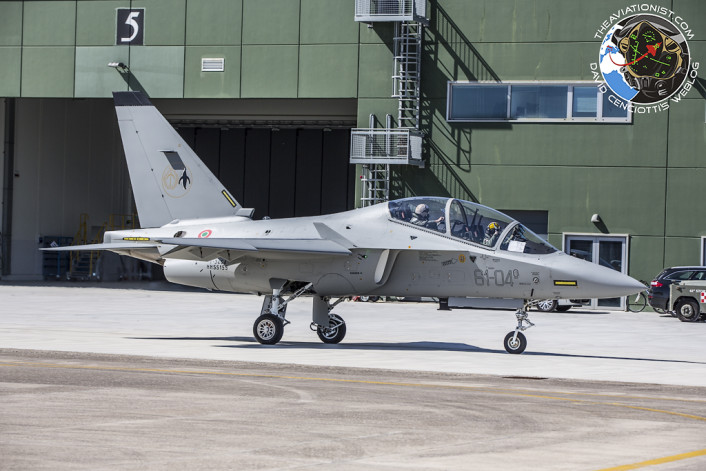
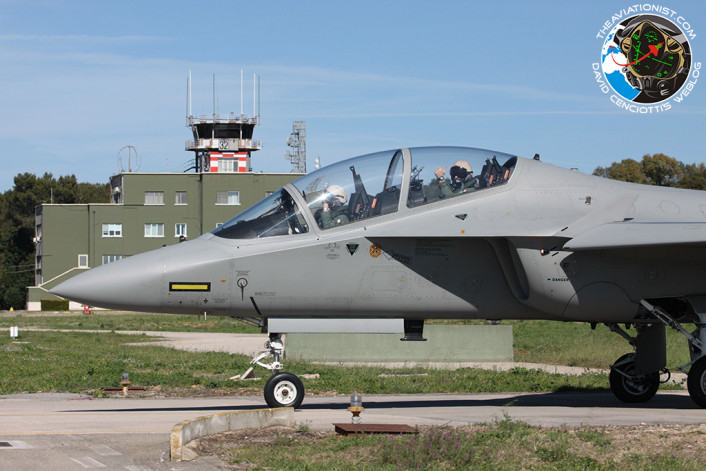
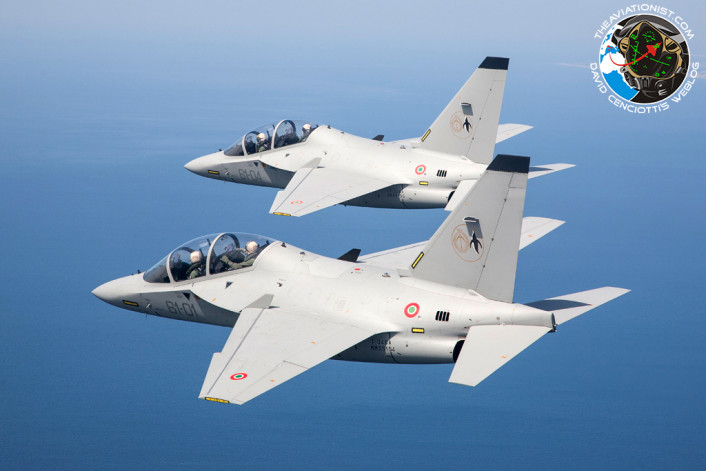
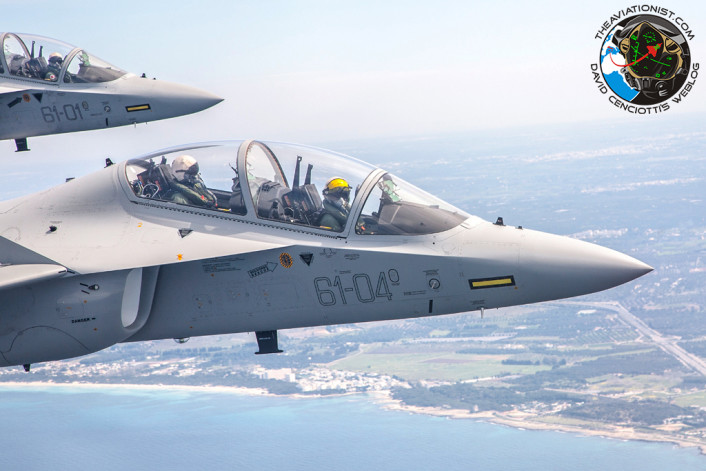
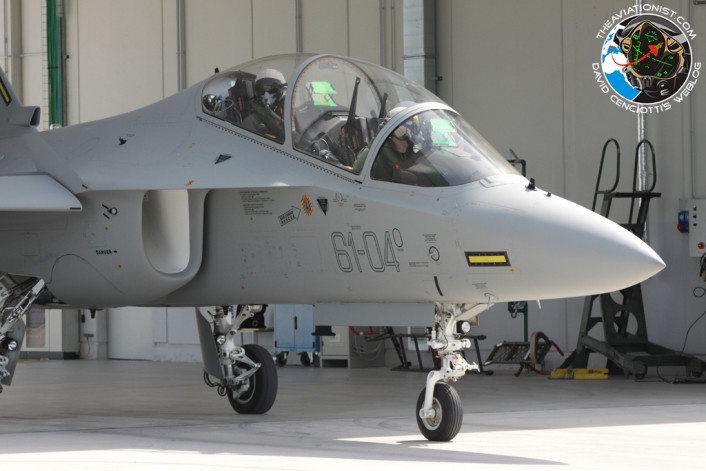
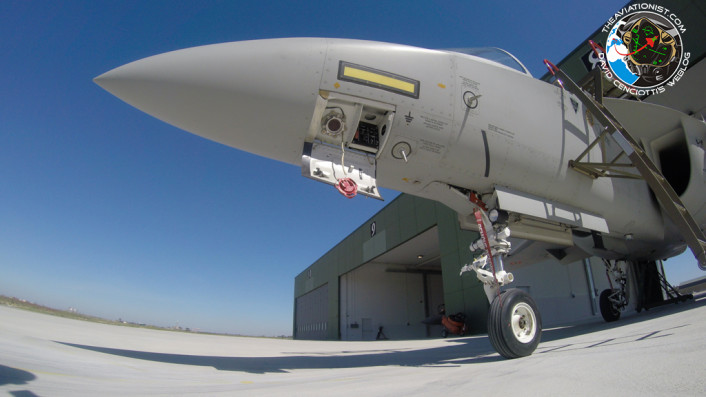
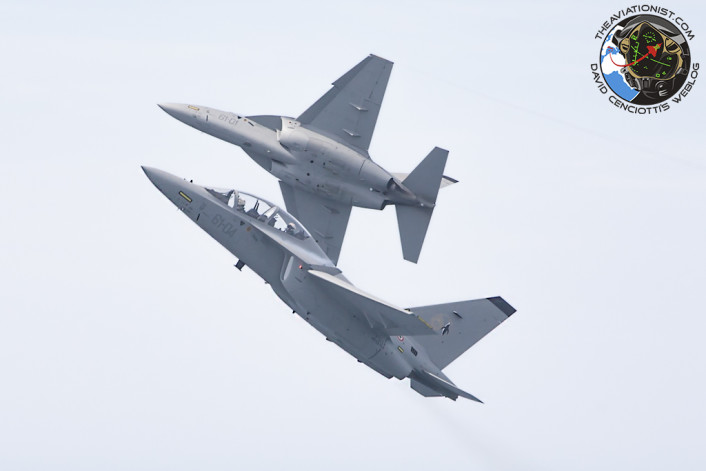
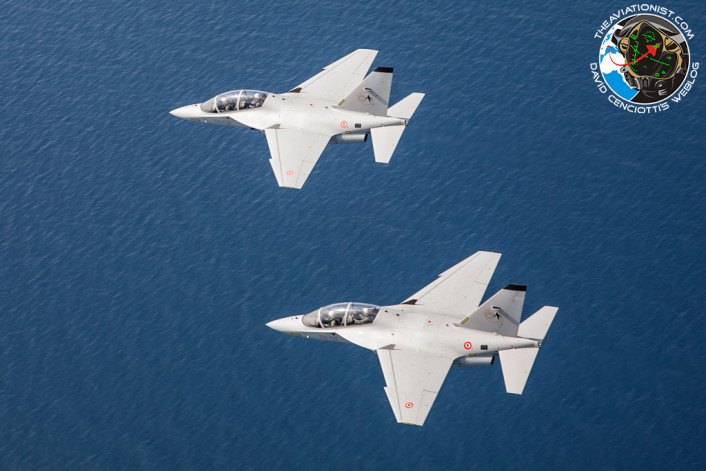
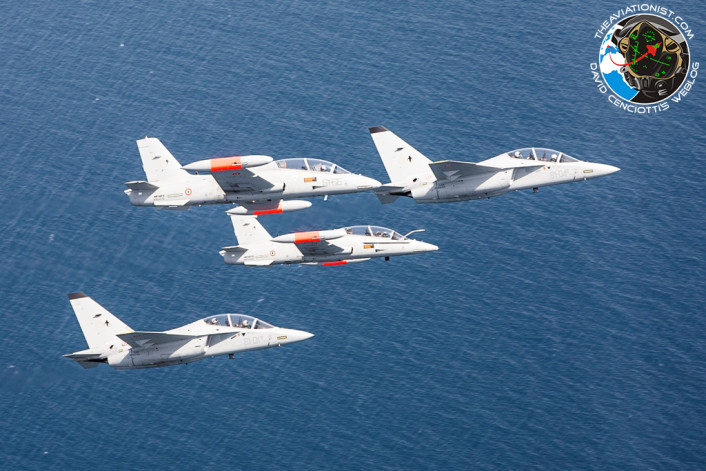
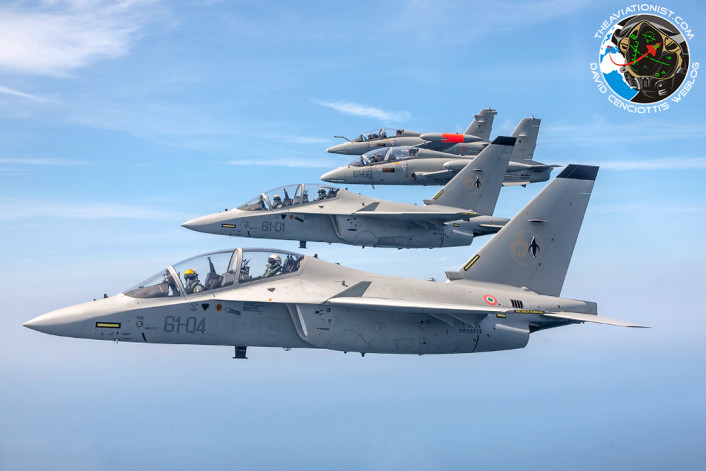
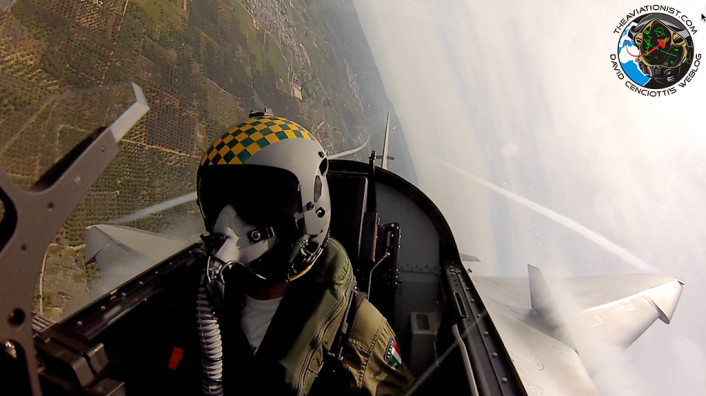
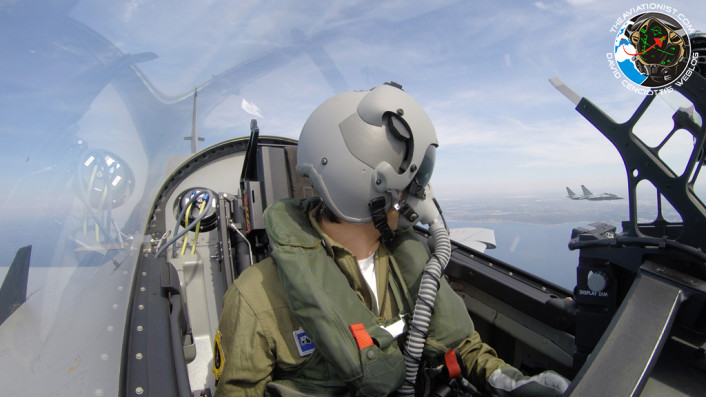
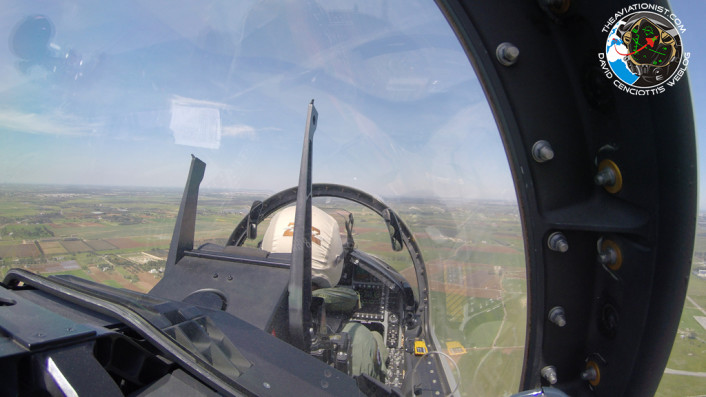
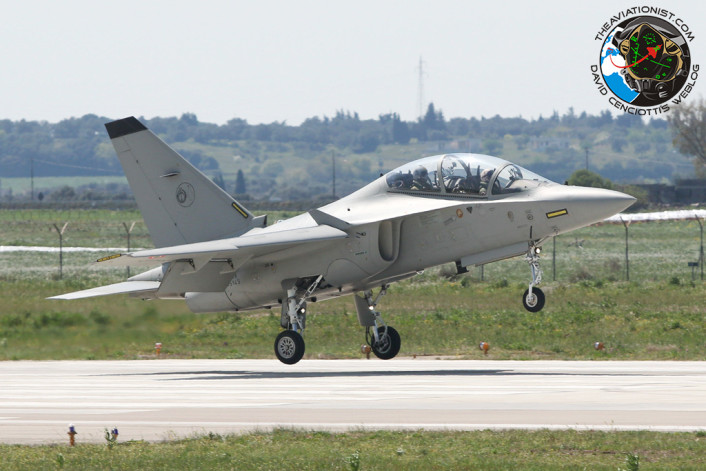
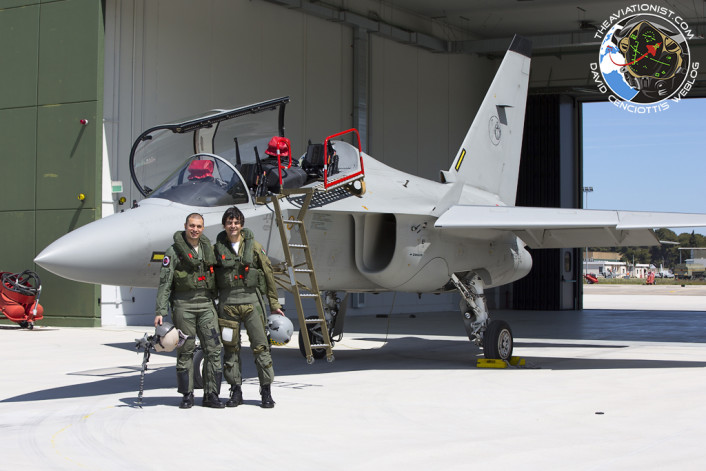
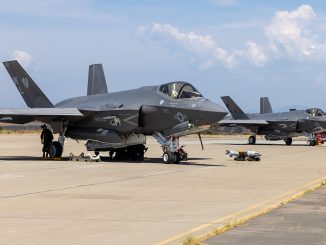
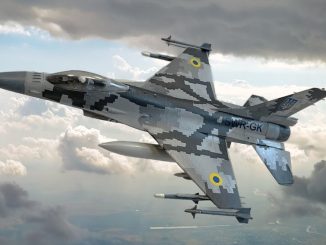
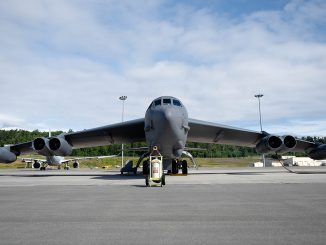

No comments:
Post a Comment